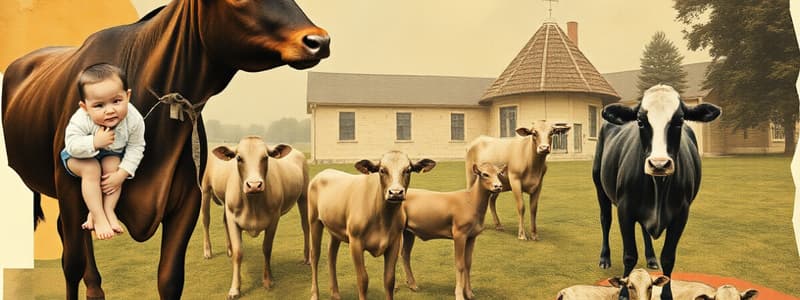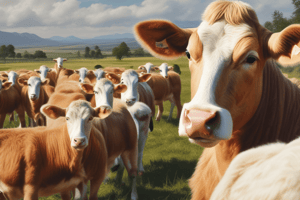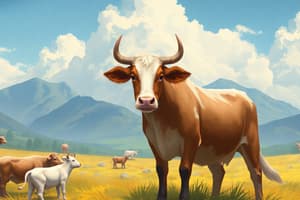Podcast
Questions and Answers
Which of the following is a general welfare practice needed for all species?
Which of the following is a general welfare practice needed for all species?
- Genetic selection
- Competitive events
- Providing entertainment
- Regular monitoring (correct)
Goats do not require any specific fencing for protection from predators.
Goats do not require any specific fencing for protection from predators.
False (B)
Which practice is essential for preventing hoof-related problems in animals?
Which practice is essential for preventing hoof-related problems in animals?
- Vaccinations
- Routine hoof trimming (correct)
- Daily exercise
- Regular feeding
What is essential for a balanced diet in animals?
What is essential for a balanced diet in animals?
Isolation of animals can promote their welfare and reduce stress.
Isolation of animals can promote their welfare and reduce stress.
Animals require a dry and well-ventilated environment to prevent issues caused by ______.
Animals require a dry and well-ventilated environment to prevent issues caused by ______.
Name one aspect of routine checkups in veterinary care.
Name one aspect of routine checkups in veterinary care.
Match the following animal care practices with their descriptions:
Match the following animal care practices with their descriptions:
Animals should have the freedom to express their normal ______, such as social interactions and movement.
Animals should have the freedom to express their normal ______, such as social interactions and movement.
Match the following aspects of the five freedoms to their descriptions:
Match the following aspects of the five freedoms to their descriptions:
What is the recommended period of rest from artificial lighting for sheep?
What is the recommended period of rest from artificial lighting for sheep?
Obesity in pregnant ewes poses no significant health risks.
Obesity in pregnant ewes poses no significant health risks.
What score indicates emaciation in sheep using body condition scoring?
What score indicates emaciation in sheep using body condition scoring?
Sheep can recognize the faces of numerous other sheep and interpret the __________ relevance of these facial features.
Sheep can recognize the faces of numerous other sheep and interpret the __________ relevance of these facial features.
Match the body condition score with its corresponding sheep health status:
Match the body condition score with its corresponding sheep health status:
What does the Indigenous concept of animal personhood emphasize?
What does the Indigenous concept of animal personhood emphasize?
Healthy sheep in good condition can cope well in cold conditions.
Healthy sheep in good condition can cope well in cold conditions.
What should be done to protect sheep at risk of hypothermia during cold conditions?
What should be done to protect sheep at risk of hypothermia during cold conditions?
The Indigenous perspective often views animals as ___ or kin.
The Indigenous perspective often views animals as ___ or kin.
Match the following conditions with their effects on sheep welfare:
Match the following conditions with their effects on sheep welfare:
What is one action recommended for managing sheep during severe weather?
What is one action recommended for managing sheep during severe weather?
Wind chill has no effect on the effective temperature experienced by sheep.
Wind chill has no effect on the effective temperature experienced by sheep.
What must be kept within the standard range to ensure the welfare of sheep?
What must be kept within the standard range to ensure the welfare of sheep?
Flashcards
Routine checkups
Routine checkups
Regular veterinary visits to ensure your animal is up-to-date on vaccinations, parasite control, and overall health.
Hygiene
Hygiene
Maintaining a clean environment for the animal, including regular cleaning of feeding and watering equipment, to prevent the spread of diseases.
Hoof care
Hoof care
Regular trimming of hooves to prevent infections like footrot and lameness.
Parasite control
Parasite control
Signup and view all the flashcards
Freedom from hunger and thirst
Freedom from hunger and thirst
Signup and view all the flashcards
Shelter in animal care
Shelter in animal care
Signup and view all the flashcards
Appropriate fencing in animal care
Appropriate fencing in animal care
Signup and view all the flashcards
Space requirements for animals
Space requirements for animals
Signup and view all the flashcards
Nutritional needs of animals
Nutritional needs of animals
Signup and view all the flashcards
Water for animals
Water for animals
Signup and view all the flashcards
Sheep Facial Recognition
Sheep Facial Recognition
Signup and view all the flashcards
Sheep Social Hierarchy
Sheep Social Hierarchy
Signup and view all the flashcards
Sheep Socialization
Sheep Socialization
Signup and view all the flashcards
Sheep and Photoperiod
Sheep and Photoperiod
Signup and view all the flashcards
Sheep Body Condition Scoring
Sheep Body Condition Scoring
Signup and view all the flashcards
Indigenous concept of animal personhood
Indigenous concept of animal personhood
Signup and view all the flashcards
Animals as kin: Indigenous perspective
Animals as kin: Indigenous perspective
Signup and view all the flashcards
Cold stress in sheep: Coping mechanisms
Cold stress in sheep: Coping mechanisms
Signup and view all the flashcards
Cold stress in sheep: Vulnerable individuals
Cold stress in sheep: Vulnerable individuals
Signup and view all the flashcards
Wind chill in sheep
Wind chill in sheep
Signup and view all the flashcards
Cold stress in sheep: Management strategies
Cold stress in sheep: Management strategies
Signup and view all the flashcards
Sheep environment: Physical factors
Sheep environment: Physical factors
Signup and view all the flashcards
Sheep environment: Social factors
Sheep environment: Social factors
Signup and view all the flashcards
Study Notes
Lecture 3: Animal Care and Welfare
- Lecture covers animal care and welfare, comparing European and Indigenous perspectives with Canadian perspectives.
Today's Topics
- Introduce welfare practices for beef, sheep, and goats.
- Define and compare European vs. Canadian welfare standards.
- Define Indigenous concept of animal personhood and animals as ancestors.
Learning Objectives
- Compare and contrast animal welfare principles.
- Apply animal welfare principles to develop safe animal handling and housing procedures.
General Welfare Practices
- Housing and environment: Shelter, fencing, space, appropriate environment.
- Nutrition: Balanced diet, varied nutritional needs, fresh water.
- Healthcare: Routine checkups, hygiene, hoof care, parasite control, vaccinations.
- Behaviour and welfare: Flocking, isolation, handling techniques, proper training.
Housing and Environment Details
- Shelter protects from rain & extreme weather (cold, hot, wind).
- Well-ventilated & dry environment.
- Sufficient fencing for predator protection & to prevent escapes (goats).
- Adequate space prevents stress & injury, avoids overcrowding.
- Goats need climbing space and environments.
Nutrition Details
- Balanced diet crucial with forage (grass, hay), grains, and minerals.
- Body score monitoring for diet adjustments.
- Nutritional needs vary with animal age and stage.
- Fresh, drinkable water always available.
Health Care Details
- Regular veterinary checkups for vaccinations, parasite control, health monitoring.
- Clean living conditions to prevent disease spread (cleaning feeding and water equipment).
- Hoof trimming prevents infections (footrot) & lameness.
- Deworming program necessary to control parasites.
- Vaccinations scheduled to maintain protection.
Behaviour and Welfare Details
- Animals are social and should remain in groups (flocking, goats specifically).
- Isolation may lead to stress and behavioural problems.
- Low-stress handling techniques and appropriate training for handlers.
European Welfare Standards (Five Freedoms)
- Freedom from hunger & thirst: Fresh water & suitable diet.
- Freedom from discomfort: Suitable living environment & bedding.
- Freedom from pain, injury, & disease: Prevention and veterinary care.
- Freedom to express normal behaviour: Allowing social interactions and movement.
- Freedom from fear & distress: Gentle handling.
Canadian Welfare Standards
- Combination of federal, provincial, & territorial regulations.
- Specific code of practice available at a website address (provided).
Indigenous Concept of Animal Personhood
- Complex concept, highlighting a deep and respectful relationship.
- Animals are viewed as sentient beings with their own identities, rights, and roles.
- Value placed on life in all forms within the natural world.
Indigenous Concept of Animals as Kin
- Animals viewed as relatives or kin in Indigenous culture.
- Recognizes respect and obligation towards animals, their role, and life within the ecosystem.
Cold Stress in Sheep
- Mature sheep in proper condition with access to feed, water, & shelter can withstand cold.
- Young, shorn, or compromised sheep more susceptible to hypothermia.
- Sheep in a cold condition: face away from wind, seek shelter, huddle, shift positions, shiver.
Wind & Cold Conditions Affecting Sheep Welfare
- Wind combined with cold & wet conditions compromise sheep welfare.
- Wet conditions reduce fleece insulation.
- Wind chill negatively impacts the effective temperature & can cause hypothermia.
Action for Sheep in Cold Conditions
- Relocate to a sheltered area.
- More feed.
- Extra bedding.
- Manage shearing events (delay during bad weather).
- Manage air circulation, dust, CO2, temperature, humidity, and ammonia concentrations.
Social Environment of Sheep
- Social animals, flock behaviour for protection from predators.
- Strong social bond between dam and lambs, intact until separation.
- Subgroups form within flocks.
- Recognize faces and interpret emotional cues.
- Fighting and establishing hierarchy more in single-sex, single-age groups.
- Visual contact crucial to avoid isolation stress.
Lighting and Sheep
- Seasonal animals, sensitive to photoperiod.
- Appropriate rest period from artificial lighting, but not continuous darkness.
- Prefer areas moving from darker areas to lighter ones, shadows can be disruptive.
Nutrition and Feed Management
- Farm husbandry & management significantly influence body condition and sheep welfare.
- Emaciation and obesity negatively impact health & welfare.
- Ewe condition crucial to lamb development and survival.
- Obesity, especially during pregnancy, can lead to complications.
- Condition scoring most applicable to mature animals.
- Feeding space affected by feed type, frequency, horned animals, size & group size.
Studying That Suits You
Use AI to generate personalized quizzes and flashcards to suit your learning preferences.




